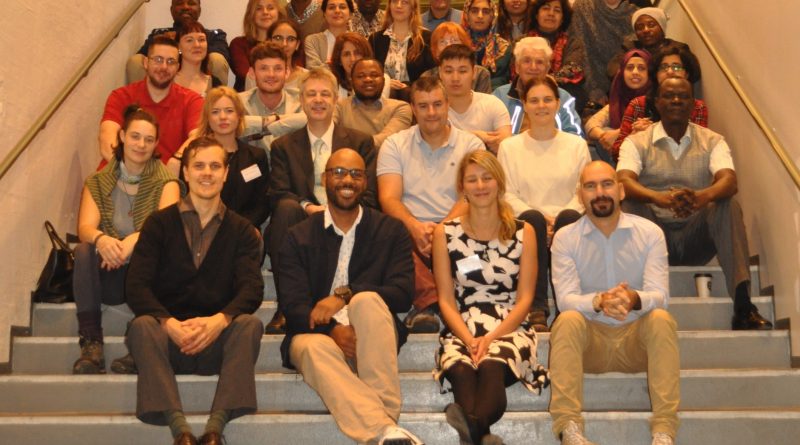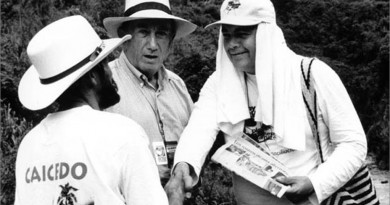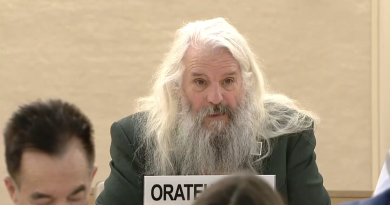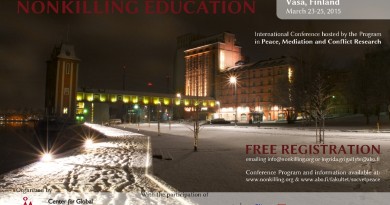How Musicking can Support Nonkilling and Peacebuilding
On September 18-20, 2017, the Center for Global Nonkilling and the Programme in Peace, Mediation and Conflict Research at Åbo Akademi University in Vasa, organized an international exploratory interdisciplinary conference focusing on the topic “Musicking and Nonkilling for Peacebuilding: Crises, Dangers and Opportunities.” The conference received international attention, including a news article in page two of the Japanese Seikyo Shimbun newspaper (circulation, 5.5 million). As part of the conference, graduate students of the MA in Peace, Mediation and Conflict research prepared a report on the findings, that is reproduced below. The report was aimed at peace students and researchers from around the world.
Findings of the International Conference on Musicking & Nonkilling for Peacebuilding: Crises, Dangers and Opportunities. 18-20 September 2017, Åbo Akademi, Vasa
Dear Peace Students,
We would like to introduce you to the concept of musicking in relation to nonkilling and peacebuilding and draw your attention to the conference on Musicking & Nonkilling for Peacebuilding, which was organized by the programme in Peace, Mediation and Conflict Research at Åbo Akademi and the Center for Global Nonkilling (CGNK), Sept. 18-20, 2017 in Vaasa, Finland at Åbo Akademi. An additional report on the conference prepared by the Director of the Min-On Music Research Institute (MOMRI) is also available online.
Academic research on the connections between musicking and nonkilling as well as peacebuilding is still new, and we thought it useful to share information gained at the conference with other peace students. The first academic book on the topic was published in 2008, and re-edited in 2015: Music and Conflict Transformation: Harmonies and Dissonances in Geopolitics (London: I.B. Tauris, edited by Olivier Urbain). We will briefly explain the key concepts and give examples of how musicking is already being used. We will also point out how students, researchers and practitioners can further develop the field.
Music and peacebuilding, independently, are fields that have received great attention, each of them being academic disciplines with their own goals, traditions and vocabulary. By sharing this paper with peace students around the world, we hope to encourage research in combining the two in order to further develop the field. As music is already an important part of most people’s lives, it makes sense to investigate how it is connected to bringing about change on the road to a more peaceful killing-free world.
Key concepts
The term musicking, music as a verb, fell into oblivion for many decades before being revived by Christopher Small in his book titled Musicking (1998, Hanover: University Press of New England). He wrote:
The fundamental nature and meaning of music lie not in objects, nor in musical works at all, but in action, in what people do. It is only by understanding what people do as they take part in a musical act that we can hope to understand its nature and the function it fulfills in human life (1998, 8).
To music is to take part, in any capacity, in a musical performance, whether by performing, by listening, by rehearsing or practicing, by providing material for performance (what is called composing), or by dancing. We might at times even extend its meaning to what the person is doing who takes the tickets at the door or the hefty men who shift the piano and the drums or the roadies who set up the instruments and carry out the sound checks or the cleaners who clean up after everyone else has gone. They, too, are all contributing to the nature of the event that is a musical performance (emphasis in the original) (1998, 9).
With this inclusive definition, many more activities can be considered as “musicking.” In his keynote speech at the Musicking & Nonkilling for Peacebuilding conference, Olivier Urbain emphasized its importance for peacebuilding: “It’s about what we do to ourselves and to each other through music.” He also added two aspects of music(king) that are useful to conduct research on “music in peacebuilding:” ambivalence and the booster effect.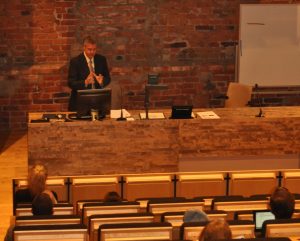
First, music is ambivalent. This notion challenges the somewhat accepted view of music as something inherently and consistently positive and warns us that music is not always a peaceful activity but can also be used in violent and brutal ways (See Nanga abahutu by Bikindi Simon, a song about killing Hutus used in the Rwandan genocide). For instance, one will obtain very different results depending on the intention of those doing the musicking. In addition, what “sounds good” to people is very relative. Someone might find disturbing the music that the other person finds the most beautiful in the world.
Second, music might not have some great intrinsic power, but it can be used as a booster to preexisting activities, thus enhancing them. For example, therapy is an activity that requires competences, training, careful applying; then, when adequately added, music can contribute to the therapeutic effects. Music can also enhance the lyrics and together they form a song which carries and enhances verbal messages (See We Shall Overcome, a song widely used in the US Civil Rights movement or Stimela by Hugh Masekela).
Nonkilling is a concept that addresses the absence of killing or killing related activities (threats, conditions) in human societies (humans killing humans at least, being extensive to animals). It was developed by Glenn Paige and presents a relatively clear concept, with an emphasis on what is measurable, which makes it effective in scientific research on peace and violence. The mission of the CGNK is “to promote change toward the measurable goal of a killing-free world”. The methods and means of realization are open to infinite human creativity.
The conference explored how these two concepts, musicking and nonkilling, can contribute to peacebuilding. In addition, there was a strong emphasis on the necessity to integrate three categories of professions that often do not collaborate on this issue: musicians (and the music industry), activists and researchers. In order to ensure significant advances in the field of music in peacebuilding, with its highly interdisciplinary and multidisciplinary aspects, it is important to achieve more integration. An example of an institute that integrates all three under the same umbrella is the Min-On Music Research Institute (MOMRI) in Japan, founded by Daisaku Ikeda. The Institute’s mission is “to pursue a multidisciplinary investigation of the potential application of music in peacebuilding activities.”
Examples of Musicking around the World
Norges Fredslag (Norwegian Peace Association) is an independent NGO, which is working towards lasting world peace. Alexander Harang, head of the organisation, who has been a professional musician as well as doing research on peace before, sees music as a vehicle for both ideas and values artists seek to foster in society rather than a mere tool for entertainment. Musicians have the potential to communicate through platforms, which can reach people through a universal language and thus influence peace activism. Certain artist communities are even established to promote peace directly. The International Committee of Artists for Peace (ICAP) was founded by artists and serves the mission to “build a culture of peace and develop future peacemakers through the transformative power of the arts”. For this, musicians are engaging in peace education, giving free performances at peace events and donating a share of concert revenue to associations active in the field.
During his presentation, Joám Evans Pim (director of CGNK) presented his original research on song duels, particularly addressing the Galician “Requeifa“, which can be considered a form of conflict management or resolution. A song duel mainly involves two individuals and its aim is to prevent physical aggression. The reasons for the dispute between the participating individuals can be anything from hostility, greed, land disputed, etc. Song duels have a clear set of rules that state how the contest will proceed and the participation of the audience helps to ensure that these rules are respected, while promoting restraint among the participants. Contestants provide lyrical blows to each other in a quick flowing manner in which humor and fun is used. Insults can be used as well but these are not taken personally as the focus is more on ridiculing and mocking one’s opponent. Duels can go on for hours and require creativity and oral improvisation skills. The audience decides the winner and results are considered binding. Song duels take place all over the world and over time have also involved to be more appealing to a younger crowd, an example of this would be “battle” within the hip-hop genre.
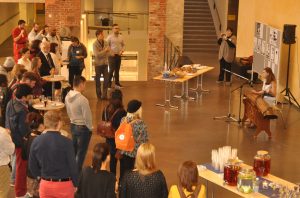 Barbora Xu is a Czech musician living in Finland who works on bridging the gaps between different cultures through the use of music. She is studying East Asian cultures and has been researching the Bunun tribe in Taiwan in her fieldwork. Combining the three roles of a musician, activist and researcher, Barbora Xu arranges songs from one specific culture on traditional instruments of another culture – e.g. Bunun songs on the Finnish Kantele. She thus shows the audience how close folk songs of different cultures are to each other. In her performances she gives information on the instruments and lyrics she’s using and encourages visitors to take part e.g. by handing out lyrics of Chinese folk songs which then the Finnish audience can sing along to.
Barbora Xu is a Czech musician living in Finland who works on bridging the gaps between different cultures through the use of music. She is studying East Asian cultures and has been researching the Bunun tribe in Taiwan in her fieldwork. Combining the three roles of a musician, activist and researcher, Barbora Xu arranges songs from one specific culture on traditional instruments of another culture – e.g. Bunun songs on the Finnish Kantele. She thus shows the audience how close folk songs of different cultures are to each other. In her performances she gives information on the instruments and lyrics she’s using and encourages visitors to take part e.g. by handing out lyrics of Chinese folk songs which then the Finnish audience can sing along to.
In Vasa, musicking is used by different individuals and organizations to work towards mutual (intercultural) understanding and strong communities. Four examples were presented at the conference which we would like to mention here: Lina Teir is a songwriter and storyteller from Kristinestad, a town close to Vaasa. She organizes storytelling events with refugees, giving the usually unheard ones a voice. By speaking and writing about those experiences, she makes them known to a wider audience, believing that listening and sharing our stories with each other are the key ingredients to a peaceful society.
“A Bigger Heart” project, started by a group of musicians who wanted to use their art to have a positive impact. Members of the project have since been using drama, music and dance to promote tolerance and togetherness, their motto being “all are equal”. A similar approach is being used by the multicultural association Kpanlogo Yede. By providing courses in African Drumming and Dance, it aims at giving people an insight into different cultures and merging them. Mira International Culture Society also provides spaces for Finns and immigrants to come together and get to know each other, music often playing an important role in those events.
Conclusions
Though the conference has ended weeks ago, the ideas, research, presentations and practice of musicking and nonkilling in peacebuilding presented at the event have lived on in our group discussions. The reason this document is shared with you is to provide insights into the conference, to ensure that the outcomes of the conference are known, and to increase awareness of the tremendous potential of “musicking and nonkilling for peacebuilding.”
The conference presented studies and practical examples of an academic and practical approach that offers a platform for various research and application possibilities. Based on increased awareness, a possibility to form research networks or databases is born. In addition, following suggestions to further actions were presented in our post-conference discussions.
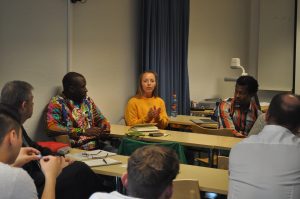
Firstly, the long-lasting nature of research and its accessibility to the wider public can be ensured with launching a website that acts as a database of musicking in peacebuilding. The suggested database could contain basic information on research on the topic, references to literature and practical examples across the world. Secondly, actions within the already existing networks can be taken as an idea to present a proposal for other countries to join the International Committee of Artists for Peace (ICAP) or to organize new national or regional branches in collaboration with them; activities such as those presented by Kpanlogo Yede or Mira could also be replicated.
With this document and recommendations, we invite fellow students and researchers to immerse themselves in research on “musicking & nonkilling for peacebuilding,” and invite you to contact us if further ideas or recommendations arise. We were privileged to be a part of the conference that broadened our academic and practical knowledge to a great extent.

